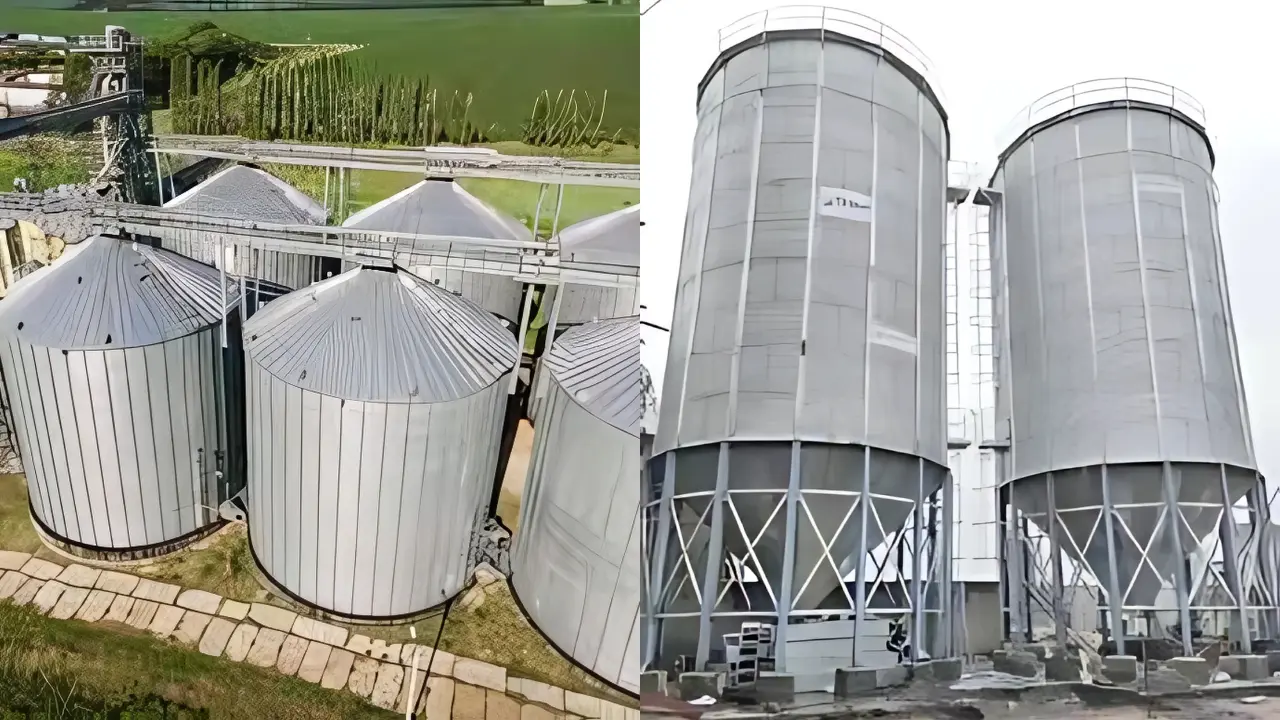When it comes to grain storage solutions, two popular silo types stand out: Hopper Bottom Silos and Flat Bottom Silos. Each has a distinct design, along with specific benefits and uses, making them ideal for various operational needs. Knowing the differences between these silo types can help you choose the best option for your grain storage requirements.
What is a Hopper Bottom Silo?
Hopper Bottom Silo is a type of grain storage structure characterized by a conical or funnel-shaped bottom. This unique design allows for the easy discharge of stored materials using gravity, making the silo self-emptying without the need for complex unloading systems. Hopper bottom silos are commonly used for storing grains, seeds, pellets, and other free-flowing materials that require quick and frequent unloading. They are often used for short-term storage or batch processes in agriculture and other industries where efficiency and cleanliness are key factors. The sloped design also minimizes residual material, reducing the risk of contamination or spoilage.
1. Hopper Bottom Silo
- Conical Bottom Design: The distinctive cone-shaped bottom allows for easy and efficient grain discharge, minimizing the need for manual intervention.
- Self-Emptying: Gravity helps in the natural flow of stored material, making these silos ideal for grains or materials that need to be frequently emptied or moved.
- Ideal for Short-Term Storage: Hopper bottom silos are perfect for temporary or batch storage where quick turnover and easy unloading are required.
- No Residual Material: The sloped bottom ensures that little to no grain remains inside the silo after unloading, reducing the risk of contamination or spoilage.
- Versatility: These silos can store a variety of materials, including grains, seeds, pellets, and other free-flowing substances.
- Easy Maintenance and Cleaning: The hopper design allows for easier access, making cleaning and maintenance less labor-intensive.
What is a Flat Bottom Silo?
Flat Bottom Silo is a type of grain storage structure with a flat, level base, designed primarily for long-term bulk storage of grains and other materials. Unlike hopper bottom silos, which have a conical bottom for easy discharge, flat bottom silos require mechanical or manual systems, such as sweep augers, to empty the stored material.
Flat bottom silos offer a cost-effective solution for storing large quantities of grain and are ideal for operations that do not require frequent unloading. They are often used in agriculture, food processing, and other industries that require the preservation of grains and other bulk materials over extended periods.
2. Flat Bottom Silo
- Flat Base Design: The silo has a level bottom, allowing for large-scale storage and stability, ideal for long-term grain storage.
- High Storage Capacity: Flat bottom silos can store significant amounts of grain, making them suitable for bulk storage operations.
- Cost-Effective: These silos are more economical for large storage needs due to their higher capacity and lower construction costs per unit of storage.
- Long-Term Storage: Designed for long-term preservation, flat bottom silos maintain grain quality with proper aeration and temperature control systems.
- Sweep Auger for Unloading: Since the flat bottom doesn’t allow for natural flow, mechanical systems like sweep augers are used to help unload the grain.
- Durable Construction: Typically made from high-quality galvanized steel, flat bottom silos are built to withstand harsh weather conditions and heavy loads.
Advantages of Hopper Bottom Silos:
- Efficient Unloading: The conical design of hopper bottom silos allows materials to flow naturally using gravity, making the unloading process quicker and easier. This is particularly beneficial for free-flowing materials like grains and powders.
- Space-Saving: Due to their compact structure, hopper bottom silos are well-suited for areas with limited space, making them ideal for smaller locations.
- Prevents Material Blockage: The funnel-shaped bottom directs materials toward the center, reducing the likelihood of blockages or bridging, which is more common in flat-bottom silos.
- Versatile for Multiple Materials: Hopper bottom silos are perfect for storing materials that flow easily, such as grains, powders, and small pellets, making them widely used in industries like agriculture, food processing, and cement.
- Lower Maintenance: The gravity-based unloading process reduces the need for additional mechanical systems, potentially lowering maintenance costs.
Advantages of Flat Bottom Silos:
- Higher Storage Capacity: Flat bottom silos offer significantly larger storage capacities compared to hopper bottom silos, making them ideal for large-scale industrial operations requiring bulk material storage.
- Flexible Unloading Options: These silos can be fitted with various unloading systems like conveyors, augers, or aeration systems, which can be customized based on the type of material and unloading needs.
- Ideal for Long-Term Storage: Flat bottom silos are designed for long-term storage, capable of holding a wide range of materials, including those that may be harder to unload or require controlled conditions like temperature and moisture regulation.
- Cost-Effective for Large Operations: For businesses needing extensive storage, flat bottom silos are more economical due to their larger capacity and ability to store materials for extended periods.
- Stable Structure: The evenly distributed weight across the base provides a stable foundation, reducing the risk of structural issues over time and ensuring durability
Applications
- Hopper bottom silos are commonly used in agriculture for the short-term storage of grains, seeds, and other free-flowing materials. Their easy unloading system allows for quick transfer of these materials to trucks or processing plants.
- Flat bottom silos are widely used for long-term bulk storage of grains like wheat, corn, and barley. Their large capacity makes them ideal for grain elevators and large farms storing seasonal harvests.
When to Choose a Hopper Bottom Silo for Grain Storage?
If your facility has limited space and needs fast, efficient unloading, a Hopper Bottom Silo is an excellent choice for your grain storage needs. These silos are ideal for operations where quick unloading is crucial and the grain flows easily. They are also perfect for smaller-scale operations or farms that don’t require the storage of large grain volumes.
Best For:
- Large-scale grain storage operations
- Long-term grain storage needs
- Facilities with a high volume of grain to store and distribute
Conclusion:
Deciding between a Hopper Bottom Silo and a Flat Bottom Silo depends on factors like the size of your operation, the amount of grain to be stored, and your specific unloading requirements. For smaller operations needing fast, gravity-assisted unloading, a Hopper Bottom Silo is the right fit. However, if you’re handling large quantities of grain that require long-term storage and more unloading flexibility, a Flat Bottom Silo is the better choice. Orison Industries, is leading manufacturer & supplier of Flat Bottom Silos, Hopper Bottom Silos, Zincalume Water Storage Tank Manufacturer, Zincalume Tank and more. So if you are interested so contact us:


